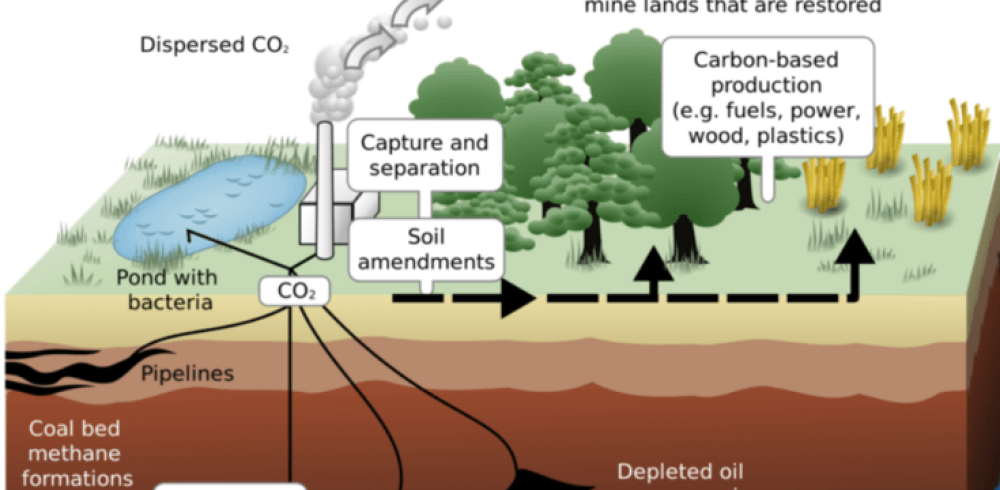For all the international negotiations on reducing carbon emissions, the commitments by 147 countries in preparation for the Paris climate talks are not adding up to be enough to prevent damage, according to the United Nations in an analysis released Friday.
But thereâs another way to tackle the problem: Remove carbon from the air.
That was the topic of a provocative session at VERGE 2015 in San Jose last week at which Noah Deich, founder of a non-profit business incubator called the Center for Carbon Removal, discussed the concept with several scientists and entrepreneurs working on in the field.
Scientists â and now U.N. officials â are worried that reductions in carbon emissions will be too gradual, he said. “So, we have to get rid of what we have.”
Amanda Ravenhill, executive director of Project Drawdown and a former professor at Presidio Graduate School of Management, put it this way: When carbon emissions in the atmosphere exceed 350 parts-per-million, major climate disruption begins to happen. “We are at 400 ppm,” she said. In other words, we are beyond preventing damage by just stopping the increase.
But Ravenhill’s organization has identified 100 ways to draw carbon from the atmosphere â some major such as recycling carbon into products and some minor such as planting a tree.
“The good news is there are tons of solutions,” Deich pointed out. “We can build systems that suck carbon out of the air and then we could use that material” to build products or produce energy.
We also can return to agricultural practices in which photosynthesis is allowed to happen in abundance and take its full course so that decaying roots leave carbon in the soil, rather than release it into the air as agricultural waste would from a back of a truck or in a landfill.
In essence, there are three broad areas of carbon removal:
1. Biological solutions that allow carbon to be sucked out of the air through photosynthesis. This, of course, is already happening. But preventing deforestation and reforesting once-forested areas would allow this powerful natural carbon sink to expand. Within agriculture, it is believed that rotational grazing or allowing animals to be grass fed, from birth to finish, will regenerate the soil by allowing more plants to populate.
2. Chemical removal solutions that create products with carbon sucked from the air and recycled and combined with catalysts to make plastic-like materials.
3. Bio energy solutions that capture carbon from burning biomass to create energy and then sequestering the remaining carbon. In the field, this is called bioenergy with carbon capture and sequestration.
Friday, the U.N. Framework Convention on Climate Change released its analysis of the country commitments that have been submitted so far. It stated in summary, “The estimated aggregate annual global emission levels resulting from the implementation of the INDCs do not fall within least-cost 2 degrees Celsius scenarios by 2025 and 2030.”
So these carbon removal technologies could be important. Letâs start with the last, bio energy.
Bio energy from capturing, sequestering and burning carbon
Daniel Sanchez, a Ph.D candidate in energy and resources at the University of California, Berkeley and a researcher in the Renewable and Appropriate Energy Laboratory, has been designing a bio-energy process that captures carbon from air, burns it to produce energy and then sequesters the carbon byproducts.
He is trying to flip the fossil fuel equation on its head. “We now take carbon from the ground, bring it up and burn it. What if we reversed that?” he said.
“I am working on taking carbon dioxide out of the air, burning it and putting it in the ground, in the soil where it belongs. This is bioenergy with carbon capture and storage.”
The team has the science down in his lab at Berkeley, but he is working on developing a scalable solution that can be commercialized.
He calls it bio carbon capture sequestration because it goes beyond just capturing carbon in the air and burning it, which would be sort of carbon neutral. Sequestering what is burned removes carbon so becomes carbon negative.
“The challenge is cost,” Sanchez said at VERGE. There are two commodities created that have some value energy and carbon elimination. “But we don’t yet value one of them,” or the cost of carbon emissions in the economy because carbon does not yet have a price on it in the U.S. other than in some areas such as California where cap and trade system is play. Still, even in California, “the price of carbon is an order of magnitude smaller” than where it should be to reflect its true influence in the economy.
But the team will continue to work on making scalable, low-cost versions of the bioenergy with carbon capture and sequestration process.
Soil
The interesting thing is that soil, particularly agricultural soil, is generally carbon deficient and needs more carbon at least in most of the developed world after years of agricultural use of pesticides and fertilizers that boost the nitrogen content of soil.
According to a 2007 discovery by scientists at the University of Illinois, that deficiency results because, although soil and plants need nitrogen, adding more nitrogen to stimulate faster growth cycles also causes faster than normal decomposition cycles and stimulates the growth of microbes which feed upon the carbon and and other nutrients in the soil, thus depleting those nutrients.
Professor Peter Byck of Arizona State University is one of a growing number of proponents of changing agriculture so that plants are allowed their normal pace of photosynthesis and decay and the soil gets to reap the carbon from the process.
“Our soils should be 7, 8 or 9 percent carbon but instead they are 1 or 2 percent,” Byck said at VERGE. “No one knew when we invented nitrogen (based pesticides) that would happen.”
He advocates that cattle and other farm animals be grazed through rotational grazing and grass fed from birth to slaughter, or grass finished as they call it in the industry.
“What if the way we grazed turned the carbon problem on its head and created a carbon sink,” with methane and carbon going into the soil and oxygen being released in the air, he said.
Byck, who teaches in both the sustainability graduate program and the school of communications, has been working on both the science and the communications of this issue. After producing the acclaimed movie “Carbon Nation,” he more recently created a second film “Soil Carbon Cowboys,” that traces life on two ranches whose farmers switched from conventional cattle grazing as practiced in the U.S. for the last 50 or so years to rotational grazing without the use of fertilizers and pesticides.
Byck describes the method as returning to grazing practices of a century ago and the way bison currently grazes in the U.S. When land was plentiful, animals were allowed to roam to new areas after they chewed all the grass in one. Bison in the U.S. west still roam.
But land is no longer cheap. However, farmers can rotate grazing fields by steering cattle to stay in a new section of their fields and allowing a former grazing area to lay fallow long enough to replenish plant life and let the photosynthesis cycle complete itself so the carbon releases and stays in the soil.
Manufacturing & Engineering Magazine | The Home of Manufacturing Industry News















